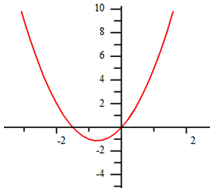Which Function Is It?
| Site: | St. Louis |
| Course: | Michigan Algebra I Sept. 2012 |
| Book: | Which Function Is It? |
| Printed by: | Guest user |
| Date: | Tuesday, December 16, 2025, 3:31 AM |
Description
Which Function Is It?
Linear or Quadratic
Linear and quadratic equations are the types of equations most commonly encountered in high school algebra and in real life applications. They are different from each other in a number of key ways.
Linear equations are usually in the form y = mx+ b . Linear functions have a degree of one, which is the main factor in determining whether it is linear or quadratic. Quadratic equations are usually in the form y = ax2 + bx + c . Quadratic functions have a degree of two, or a squared term; a linear function does not.
Examples
Example 1 Is 3x + 4 = 2y linear or quadratic?
Since the degree of the function is one, the equation is linear. In standard form the equation is 3x - 2y = -4.
Example 2 Is 4x - 3y = 2x2 linear or quadratic?
Since the degree of the function is two, the equation is quadratic. In standard form the equation is
.
Graphs
Example Is the graph below linear or quadratic?

The graph is a quadratic function because it is a U-shaped graph.
Solutions
Tables
Example 1 Does the table below represent a linear or a quadratic function?
![]()

Step 2. If the first difference is constant, the function is linear. If not, find the second difference.
The first difference is constant, so the function is linear.
The equation of the function is y = 2x + 9.
Example 2
Step 1. Find the first difference.

Since the first difference is not constant, find the second difference.

Step 3. If the second difference is constant, the function is quadratic. If not, label the function as other.
This table has a common second difference, so it is quadratic.
The function that models this table is ![]() .
.
Interactive Activities
Linear or Quadratic - Graphs
To match linear and quadratic equations with tables, select the following link:
Linear or Quadratic - Tables
Practice
Answer Key
Sources
EHow, "Differences Between Quadratic & Linear Equations." http://www.ehow.com/facts_5483849_differences-between-quadratic-linear-equations.html (accessed 8/9/2010).
Embracing Mathematics, Assessment & Technology in High Schools; A Michigan Mathematics & Science Partnership Grant Project
GeoGebra.org, "Writing Equations to Match Tables." http://www.geogebra.org/en/upload/files/english/steve_phelps/CP_Geometry/Equations_from_Tables.html (accessed 8/9/2010).
University of Vienna, "The Big Picture Puzzle." http://www.univie.ac.at/future.media/moe/tests/fun1/erkennen.html (accessed 07/27/2010).